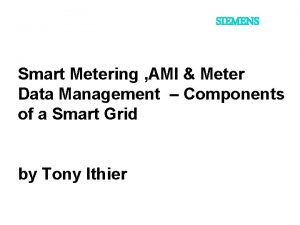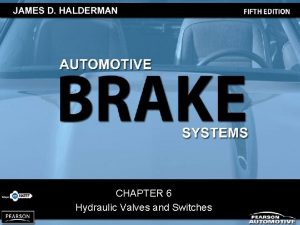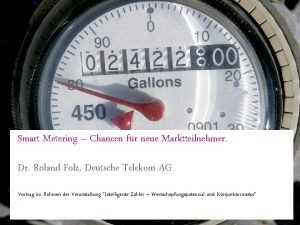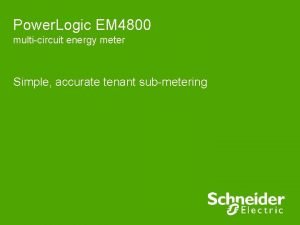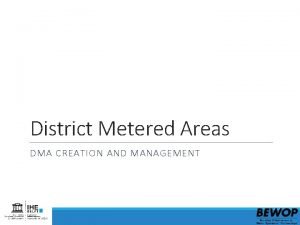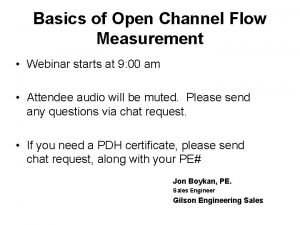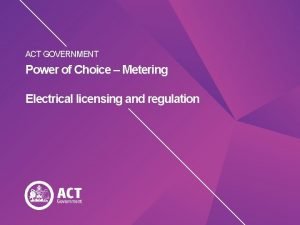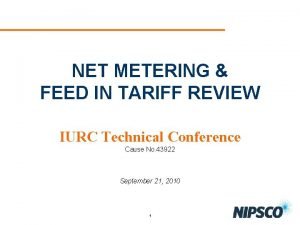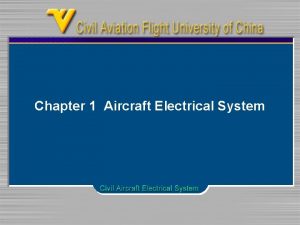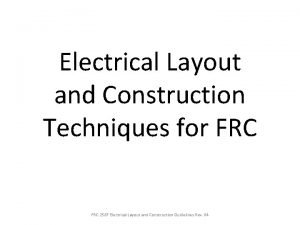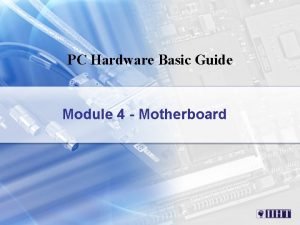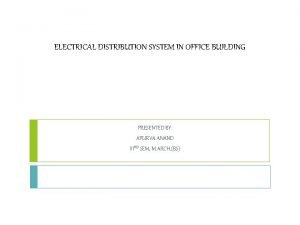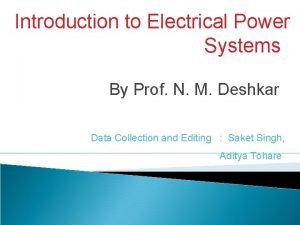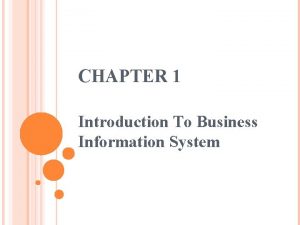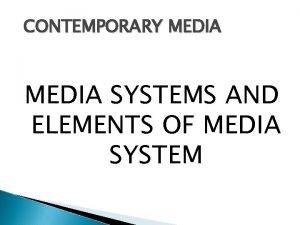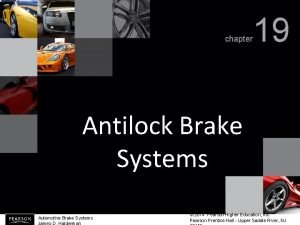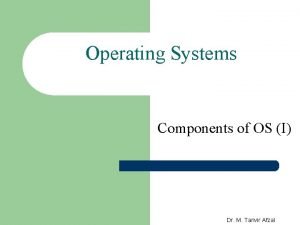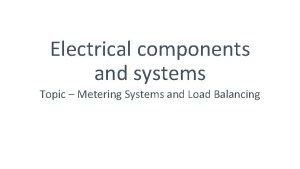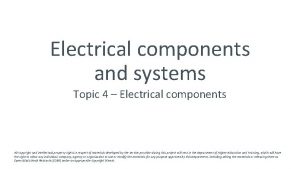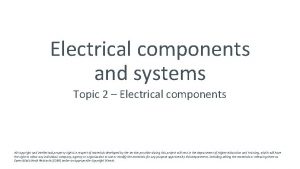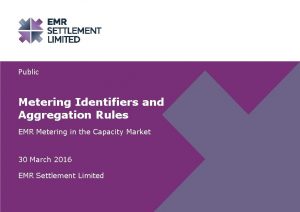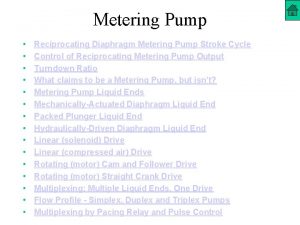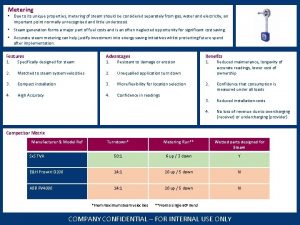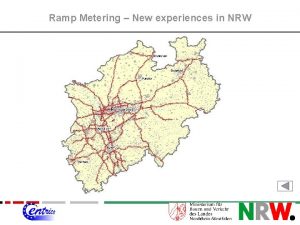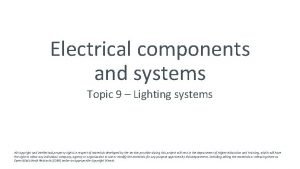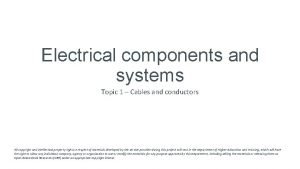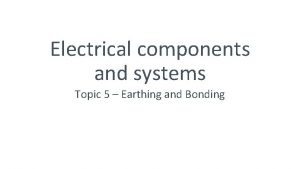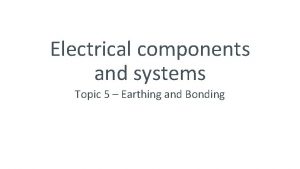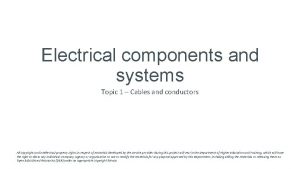Electrical components and systems Topic Metering Systems and




































- Slides: 36

Electrical components and systems Topic – Metering Systems and Load Balancing

Wire a three-phase balanced load Unit 7. 4

Assumed prior learning Connect a three phase energy meter Three phase motors • Don’t feel confident yet about these topics? Click on each to review the content. • Feeling confident? Click next to proceed with this unit.

Outcomes • Balance a three-phase load and draw the circuit diagram of the balanced load. • Wire the panel according to the diagram.

Introduction When a load is connected to a three-phase supply it is essential that it be balanced so that each phase draws the same amount of current. There a number of different types of loads that can be used, for example; lights, motors and resistance circuits and they, in turn, can be connected in a number of different ways. For example; motors in star or delta and resistance circuits and lights in parallel. In this lesson we will describe different loads that must be balanced and connected.

What is a 3 -phase balanced system? A balanced three-phase system is one in which the impedances in the three phases are identical. With such a balanced load, if a balanced three-phase supply is applied, the currents will also be balanced.

The main circuit of a balanced load The main circuit for a three-phase balanced load is exactly the same as the main circuit used for a direct-on-line starter. A lamp is added to the main circuit to indicate when the contactor is “on” and when the supply is connected to the load.

The control circuit of a balanced load The control circuit is also the same as that of a direct-on-line starter, instead of stop-start buttons, a thermostat or timer can be used as a means of control.

Different ways of connecting threephased balanced loads Figures 3, 4, 5 and 6 on the following pages show different ways of connecting three-phased balanced loads to a supply through different timers and contactor coils.

Figure 3 NOTE: You will be provided with a three -phase power supply, a number of loads as well as all the necessary tools and equipment and must be able to balance the load for the power supply, draw the circuit diagram and wire the panel. The circuit diagram must conform to the diagrams in this lesson.

Figure 4 NOTE: You will be provided with a three -phase power supply, a number of loads as well as all the necessary tools and equipment and must be able to balance the load for the power supply, draw the circuit diagram and wire the panel. The circuit diagram must conform to the diagrams in this lesson.

Figure 5 NOTE: You will be provided with a three -phase power supply, a number of loads as well as all the necessary tools and equipment and must be able to balance the load for the power supply, draw the circuit diagram and wire the panel. The circuit diagram must conform to the diagrams in this lesson.

Figure 6 NOTE: You will be provided with a three -phase power supply, a number of loads as well as all the necessary tools and equipment and must be able to balance the load for the power supply, draw the circuit diagram and wire the panel. The circuit diagram must conform to the diagrams in this lesson.

Balancing resistive loads Before the main and control circuits are wired, the load must be identified and balanced (if not exactly then as close as possible), and then drawn into the wiring diagram. The resistors will be connected between the studs as shown below: Note: Loads used further in this lesson will consist of resistors, with their values given in watts.

Balanced wattage loads This load is usually made up of six resistors of which the values are given in watts instead of ohms. When a wattage load is given, it is always correct to connect the individual resistances in parallel. The best way of explaining the method of connecting the load is by means of an example.

Example: Balanced wattage loads Balance the loads given below and connect it to a three-phase, 380 volt supply so that 220 volt flows can be measured across each phase. • 1 x 700 watts • 1 x 300 watts • 1 x 200 watts • 1 x 300 watts • 1 x 500 watts • 1 x 1000 watts The voltage in this case indicates that the total load is connected in star.

Example: Balanced wattage loads continued Procedure for wiring the load • Add the six resistors together 700 + 300 + 200 + 300 + 500 + 1000 = 3000 watts. • Divide the answer by 3 to determine the watts/phase 3000 ÷ 3 = 1000 watts per phase

Example: Balanced wattage loads continued • Use the given resistors values to form combinations that will give 1000 watts/phase. In this case the resistors will have to be connected in parallel. Phase 1: 700 + 300 = 1000 watts Phase 2: 200 + 300 + 500 = 1000 watts Phase 3: 1000 watts

Example: Balanced wattage loads continued • Connect them in the circuit as shown:

Example: Balanced wattage loads continued • Connect the three phases in star, as shown:

Example: Balanced wattage loads continued Note: For safety reasons, it is recommended that a neutral always be connected from the neutral bar to the star point on the load, as shown in the figure below, although it is strictly speaking not necessary for balanced loads.

Unbalanced wattage loads If the resistors cannot be balanced exactly, then use the following procedure: • Use the same method as described above and balance the load per phase as close as possible to each other. • Connect the resistors in parallel. This has been explained above. • Connect the three separate loads in star.

Unbalanced wattage loads continued For unbalanced loads it is imperative to connect a neutral from the neutral bar to the star point on the load as shown below:

Motor loads A motor is always treated as a balanced load. Refer to the lesson; Testing Single Phase AC Motors. The nameplate of the motor will indicate whether the motor must be connected in star or delta. Note: If the motor is to be connected in star, there is no need for a neutral.

Wire a three-phase load balanced panel • Determine the type of load and balance it according to the methods described in this lesson. • On a clean sheet of paper draw a wiring diagram of the main and control circuits with the load connected. • Test the circuit with a bell tester and mark the studs that are used for the main and control circuits. • Wire the main circuit and the load according to the wiring diagram that has been drawn. • Wire the control circuit according to the drawn diagram. • Test the completed circuit with a bell tester for correct operation. Note: Do not apply power to this panel!

Assessment criteria In practise you will be provided with a three-phase power supply, a number of loads as well as all the necessary tools and equipment and must balance the load for the power supply, draw the circuit diagram and wire the panel to the following standards: (a) The load must be balanced, if not correctly, then as close as possible, according to the examples in the module. (b) The circuit diagram must conform to the diagrams in this module. (c) The resistances must be connected in parallel. (d) The loads must be connected in either star or delta as described in an earlier lesson. (e) The indicating lamp must only operate when the contactor is “on”. (f) The timer must switch the contactor “on” or “off” at a pre-set time. (g) The wiring of the panel, the selection of the sizes and colours of conductors, and the termination of the conductors, must be according to the standards described in Wiring a panel and the SANS Code of Practice for the Wiring of Premises. (h) All the metal parts must be earthed.

Control form All the relevant safety procedures must be adhered to. Refer to the HIAC Form. HIAC FORM: Wire a three -phased balanced load

Practise Balance different sets of loads provided, draw the wiring diagrams and wire the panels. At least three loads must be correctly balanced and two panels completely wired. REMEMBER to adhere to the relevant safety procedures when doing the practical work. Refer to the HIAC Form.

Quiz time We have come to the end of this unit. Answer the following questions to make sure you understand how to work with conductors and insulators.

Question 1 Why is it necessary to balance a 3 -phase load? INSERT YOUR ANSWER HERE

Question 2 How would an unbalanced load be connected? INSERT YOUR ANSWER HERE

Question 3 A balanced three-phase system is one in which the impedances in the three phases are identical. TRUE Click on the correct answer. FALSE

Question 4 Why is an indication lamp used and where should it be connected? INSERT YOUR ANSWER HERE

Let’s review: In this lesson we have covered: üDefinition of a three-phase balanced system. üThe main circuit and the control circuit of a balanced load. üBalanced wattage loads. Make sure you have a complete understanding of all the work covered here before you start the next unit.

HIAC brief – Form 01

HIAC brief – Form 01 continued
 General subject example
General subject example /topic/ down
/topic/ down Siemens smart meter
Siemens smart meter Sage flow meter
Sage flow meter Surefire metering tube chart
Surefire metering tube chart A brake system metering valve
A brake system metering valve Decc smart metering implementation programme
Decc smart metering implementation programme Smart metering telekom
Smart metering telekom Sage metering
Sage metering Multicircuit meters
Multicircuit meters Fpl net metering
Fpl net metering District metering area
District metering area Leopold lagco flume
Leopold lagco flume Ueeneeg171a
Ueeneeg171a Net metering punjab
Net metering punjab Nipsco net metering
Nipsco net metering Diehl aquarius
Diehl aquarius Ameren net metering
Ameren net metering Odisha net metering policy
Odisha net metering policy Mt carmel electric net metering
Mt carmel electric net metering Aircraft electrical components
Aircraft electrical components Frc electrical components
Frc electrical components Module 4 topic 2 components of the space management system
Module 4 topic 2 components of the space management system Examples of supporting sentences
Examples of supporting sentences Building power distribution
Building power distribution Topic 2 free enterprise and other economic systems
Topic 2 free enterprise and other economic systems Modeling mechanical systems examples
Modeling mechanical systems examples Introduction to electrical power systems
Introduction to electrical power systems One electrical systems
One electrical systems Drivers ed module 10 topic 1
Drivers ed module 10 topic 1 Components of an operating system
Components of an operating system Components of operating system
Components of operating system Components of operating systems
Components of operating systems Introduction to business information systems
Introduction to business information systems Media systems
Media systems Cross section of antilock braking system components/systems
Cross section of antilock braking system components/systems Components of os
Components of os


